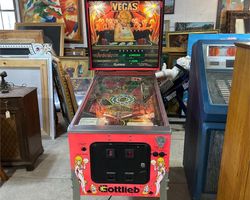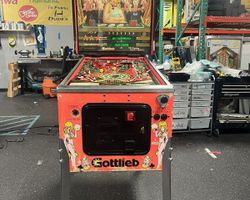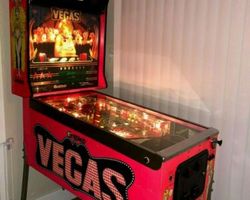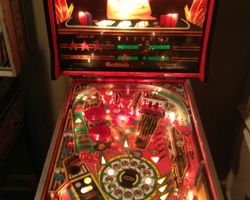Vegas
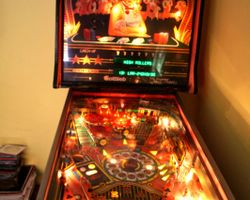
Average Prices: USD $400 to $1,400
Produced: July, 1990
Production Run: 1,500 units
Machine Type: Solid State Electronic
MPU: Gottlieb System 3
Players: 4
Design by: Jon Norris
Art by: Constantino Mitchell, David Moore, Jeanine Mitchell
"Vegas" from D. Gottlieb & Co., released in July 1990, emerged during a pivotal time for the manufacturer. With a production run of 1,500 units, this solid-state electronic (SS) machine, operating on the Gottlieb System 3 MPU, represented an experimental venture into a new design philosophy. Bearing the model number 723, "Vegas" was part of Gottlieb's "Street level" series, an initiative aimed at producing simpler, single-level, slightly smaller, and more cost-effective pinball machines. This strategic shift sought to broaden market appeal and streamline production.
The development of "Vegas" involved a dedicated team. Jon Norris was at the helm of the game's design, crafting the layout and gameplay mechanics. The visual identity of the machine was shaped by the combined talents of Constantino Mitchell, David Moore, and Jeanine Mitchell, who brought the vibrant casino theme to life through their artwork. The sonic landscape, comprising both music and sound effects, was meticulously composed by Dave Zabriskie, designed to immerse players in the thematic environment. A notable aspect of "Vegas" during its conception was the intention to include dual ramps and an additional playfield level. These ambitious features were ultimately removed, aligning the machine with the "Street level" philosophy of simplified design, a decision that speaks to the manufacturing constraints and market positioning Gottlieb envisioned for this series.
Playfield Innovation and Visual Appeal
The "Vegas" pinball machine showcases a distinct set of features that define its character and gameplay experience. Central to its visual presentation are the two 20-digit, blue Futaba alphanumeric displays. These displays, capable of rendering alphanumeric characters with commas, deliver clear scoring information, game prompts, and thematic animations that enhance player engagement. A unique electromechanical component, the Electronic Roto Unit, contributes to various in-game outcomes, often dictating mystery awards or determining progressive bonuses, injecting an element of chance and surprise characteristic of the casino theme.
Visually, "Vegas" embraces its gambling theme with a vibrant color palette and distinctive artistry. The playfield features a predominantly bright pink hue, a bold design choice that aims to capture the flamboyant essence of a casino. The artwork by Constantino Mitchell, David Moore, and Jeanine Mitchell integrates classic casino elements—roulette wheels, playing cards, and neon lights—into a dynamic composition. The lighting design works in concert with the artwork, employing a sophisticated light show that punctuates gameplay moments, creating an exciting atmosphere. This synchronization of visuals and illumination reinforces the theme, transforming the playfield into a miniature, interactive Las Vegas strip. The sound package, crafted by Dave Zabriskie, complements this sensory experience with catchy music and thematic sound effects, including bells, whistles, and vocal chants that evoke the energy of a bustling casino floor.
Dynamic Playfield and Mechanical Ingenuity
The "Vegas" playfield layout, adhering to its single-level "Street series" design philosophy, is deceptively simple yet packed with interactive elements. The primary objective is to maintain a high-paced, flowing game, which is facilitated by a well-executed loop shot that circumnavigates portions of the playfield. This shot provides a satisfying rhythm to gameplay and is crucial for building scores. In the lower playfield, two flippers control ball trajectory, guiding shots towards various targets and mechanisms.
A key interactive component is a five-bank of drop targets. These targets, strategically placed, offer a challenge to players, requiring precision shots to knock them down for points and to enable further game progression. A kick-out hole serves as an entry point for certain modes or awards, often delivering random bonuses, adding an unpredictable element to the game. Central to the theme is a representation of a slot machine, a visual and mechanical cue that ties directly into the gambling motif, triggering events or awards that mimic a casino's allure. The game also features a saucer mechanism that can award various bonuses, from extra balls to special points, keeping players anticipating the next outcome. Cards are scattered across the playfield, encouraging players to hit specific targets or complete sequences to collect them, a direct nod to poker or blackjack, integrating the theme deeply into the gameplay objectives. Despite its single-level design, the playfield feels compact and full, with each element contributing to the overall flow and player immersion. The vibrant artwork and strategic lighting on the playfield are designed to draw players into the casino atmosphere, guiding their eyes to critical shots and objectives.
Engaging Gameplay Dynamics
"Vegas" offers a gameplay experience that balances accessibility with surprising depth. The scoring system is intuitive, rewarding direct shots and successful completion of objectives. Players quickly grasp the primary goals: collecting cards, hitting drop targets, and achieving the satisfying loop shots. The game features several distinct modes and objectives that provide variety. One notable challenge is the "double or nothing" quick pick, a risk-reward mechanic that allows players to potentially multiply their points or lose them, mirroring the inherent gamble of the casino theme. This feature encourages strategic decision-making and adds an exciting tension to gameplay.
Another significant objective is the "million shot" feature, a high-value shot that requires precise execution and builds towards substantial scoring opportunities. The "cashier" bonus accumulates throughout the game, rewarding players at specific intervals or upon reaching certain milestones, providing a continuous sense of progression. Mystery awards, often triggered by the kick-out hole or the Electronic Roto Unit, inject an element of surprise, delivering random points, extra balls, or other benefits that keep players engaged. While the game's core loop of hitting targets and making satisfying shots is immediately enjoyable, the layering of these objectives and modes provides a deeper challenge for those seeking to master the machine. Players might strategize to complete card sets for a bonus, or repeatedly hit the loop shot to build score, while always considering the high-stakes "double or nothing" option.
Community Reception and Enduring Appeal
"Vegas" by Premier Technology garnered a mixed yet generally favorable reception within the pinball community. Its strengths are frequently highlighted: many players find the game's immediate appeal to be high, describing it as fun, fast-paced, and engaging, particularly for casual players. The loop shots are consistently praised for their satisfaction, contributing to the game's enjoyable flow. A significant positive is the machine's effective utilization of lights and sounds; the visuals and audio truly capture the Vegas theme, creating an exciting and immersive atmosphere. The sound package, with its catchy tunes and thematic bells and whistles, often receives accolades. While initially appearing simple, players often discover that the rules are deeper than anticipated, offering various pathways to score points and encouraging different strategies, such as collecting cards or attempting the "double or nothing" feature. Furthermore, "Vegas" is noted for its durability and the inherent reliability of the Gottlieb System 3 board system, making it a robust and dependable machine.
However, "Vegas" is not without its criticisms. Some pinball enthusiasts perceive a lack of long-term depth and challenge, suggesting that the game can be mastered quickly, potentially leading to repetitiveness for dedicated players. It is often positioned as a better fit for casual play rather than for seasoned collectors seeking complex rule sets. The single-level playfield, while intended for simplicity, is sometimes cited as contributing to this perceived lack of depth. A specific aesthetic point of contention is the bright pink playfield, which some reviewers find visually fatiguing over extended play, or suggest that the overall playfield graphics could have been more refined. Similarly, the audio, despite its initial charm, can become repetitive or even annoying to some after prolonged exposure. The fact that the machine was originally designed with dual ramps and an added level, which were ultimately removed, also fuels a sense of missed potential among some players.
Despite these critiques, "Vegas" holds a unique place in pinball history as a representative of Gottlieb's "Street series" experiment. While this particular design philosophy did not lead to widespread commercial success for Gottlieb as a whole, "Vegas" stands as an example of a manufacturer attempting to innovate by simplifying design and reducing costs. Its legacy is tied to this specific period of Gottlieb's output, offering a glimpse into a different approach to pinball machine development. For enthusiasts, it represents a reliable System 3 title that, while not reaching the broad acclaim of some contemporaries, still delivers a distinctive, enjoyable, and thematically cohesive pinball experience.
Sponsored Links
 Ebay Listings
Ebay Listings
 Auction Results
Auction Results
| Cost | Location | Date |
|---|---|---|
| USD $2,998 |  Florida, United States Florida, United States |
08 December, 2024 |
| USD $2,800 |  Arizona, United States Arizona, United States |
19 June, 2024 |
| USD $1,750 |  West Virginia, United States West Virginia, United States |
29 January, 2024 |
| EUR €855 |  Hessen, Germany Hessen, Germany |
07 November, 2021 |
| USD $2,200 |  Vermont, United States Vermont, United States |
13 February, 2021 |
| USD $1,350 |  Michigan, United States Michigan, United States |
20 November, 2020 |
| USD $1,490 |  Michigan, United States Michigan, United States |
09 October, 2020 |
| USD $745 |  Florida, United States Florida, United States |
01 December, 2015 |
| USD $1,200 |  Florida, United States Florida, United States |
27 November, 2014 |
| AUD $1,050 |  South Australia, Australia South Australia, Australia |
28 July, 2013 |


Private Policy · Search Website · Contact Us
As an eBay Partner, we may earn a commission from qualifying purchases made through links on this site, at no additional cost to you.
All trademarks and copyrighted materials remain property of their respective owners. All other content copyright 2007 - 2025 Pinpedia.

